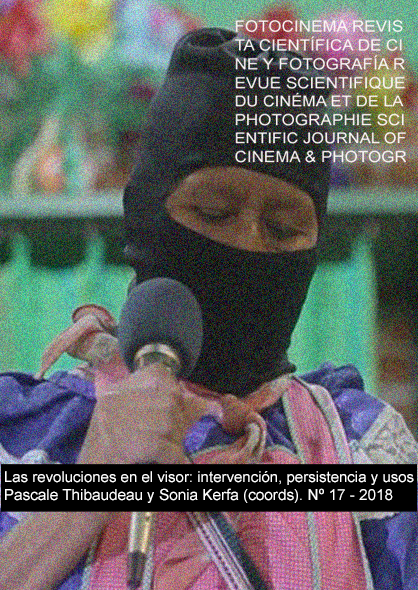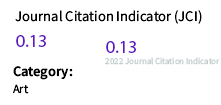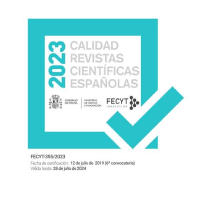Registering the image of people to bring back to the people. Images by and for the revolution: Mozambique and the cinema
DOI:
https://doi.org/10.24310/Fotocinema.2018.v0i17.5111Keywords:
Mozambique, Revolution, Cinema, FRELIMO, Documentary, NarrativeAbstract
Only in two historical moments, film and revolution have assumed a symbiosis that has made them go together in a joint evolution. The first of these moments is well known: the Russian Revolution and the Soviet cinematographic avant-garde. The other historical moment is undoubtedly influenced by the previous one, but it is almost unknown and responds to the independence of Mozambique, the birth of this nation, which meant also the birth of Mozambican film. This film emerged as an instrument of education and ideological propaganda, closely indeed to the evolution of the country. This article focuses in the analysis of the evolution of that cinematographic and historical revolution and in the filmographies of two filmmakers linked to the history of Mozambican cinema: Licinio Azevedo and Margarida Cardoso; Azevedo develops a first role, and Cardoso the part of a privileged witness of the evolution of Mozambique's cinema, and of his transition from documentary to fiction. Both filmmakers present exciting filmographies about a cinematographic and historical revolution that deserves to be considered. Both represent crossed roads that speak of revolution, memory, failure and absence, through the construction of personal universes intertwined with the social and political history of Mozambique.Downloads
Metrics
References
Cabaço, J. L. (2017). Notas para uma contextualizaçao do cinema moçambicano. Revista Mulemba. Rio de Janeiro: UFRJ. Vol. 9, nº 17. Janeiro-julho, pp. 90-98.
Convents, G. (2011). Os Moçambicanos perante o cinema e o audiovisual. Dockanema: Cape Town.
Da Silva, A. M. (2016). Archives, memories, and colonial resistance in the work of the Portuguese filmmakers Margarida Cardoso and Flipa Cesar. Journal of Romance Studies. Vol 16, nº 12, pp. 96-111.
Lança, M. (2015). Entrevista a Margarida Cardoso, a partir de Yvonne Kane. Buala: Cara a Cara. 5 de marzo. http://www.buala.org/pt/cara-a-cara/entrevista-a-margarida-cardoso-a-partir-de-yvone-kane.
Lopes, J.M. (2016). Cinema de Moçambique no pós-indepêndencia: una trajetória. Revista Brasileira de Estudios de Cinema e Audiovisual. Vol. 15, nº 2. Julio-diciembre, pp. 1-30.
Manjate, T. (2017). Virgem Margarida e a Última Prostituta: a morte das fronteiras entre a documentário e a ficçao. Revista Mulemba. Rio de Janeiro: UFRJ. Vol. 9, nº 17. Janeiro-julho, pp. 112-121.
Pereira, A. C. & Cabecinhas, R. (2016). Um país sem imagem é un país sem memória… Entrevista con Licinio Azevedo. Estudios Ibero-Americanos. Porto Alegre. Vol. 42, nº3. Sept-dez, pp. 1026-1047.
Rincón Yohn, M. del; Torregrosa Puig, M. y Cuevas Álvarez, E. (2017). La representación fílmica de la memoria personal: las películas de memoria. Revista Zer. Vol. 22, nº 42, pp. 175-188.
Santana França, A. (2017). A produçao documentarista de Licinio Azevedo: imagens, discursos e narrativas moçambicanas do pos-independência. Revista Mulemba. Rio de Janeiro: UFRJ. Vol. 9, nº 17. Janeiro-julho, pp. 99-111.
Schefer, R. (2016). Mueda, Memória e Massacre by Ruy Guerra and the Cultural Forms of the Makonde Plateu. Comunicaçao e Sociedade. Vol. 29, pp. 53-77.
Schefer, R. (2012). O nascimento da ficçao. Poiésis. Revista do Programa de Pós-Graduaçao- Mestrado. Universidade do Sul da Santa Catarina. Tubarao. Vol. 5, nº 9. Jan./Jun, pp. 260-279.
Soranz Soranz, G. (2014). O Instituto Nacional de Cinema e outras expêriencias audiovisuais em Moçambique no seu período póscolonial. Contemporanea. Comunicaçao e Cultura. Vol. 12, nº 1. Jun-abr, pp. 147-164.
Sousa Dias, V. & Cipriano M. (2010). Entrevista Margarida Cardoso. Novas & Velhas tendências no cinema português contemporâneo. Centro de Investigaçao em Artes e Comunicaçao (CIAC), pp. 125-136.
Stock, R. (2016). Cinema and Conflict in Postcolonial Mozambique: Archival Images as Illustration and Evidence. En Estas sao asa armas. Mediations of Disruption in Post-Conflict Cinema. Martins, A. Et al (Ed.). London, pp. 75-91.
Vieira, E. (2013). Politics and the Aesthetics of Absence in Margarida Cardoso’s Cinematic Work. Hispanic Research Journal, Vol 14, nº 1. february, pp. 67-85.
Downloads
Additional Files
Published
How to Cite
Issue
Section
License
All contents published in Fotocinema Revista científica de cine y fotografía are protected under the Creative Commons Attribution-NonCommercial-ShareAlike 4.0 International (CC BY-NC-SA 4.0) license. All about this license is available in the following link: <http://creativecommons.org/licenses/by-nc-sa/4.0>
Users can copy, use, redistribute, share and exhibit publicly as long as:
- The original source and authorship of the material are cited (Journal, Publisher and URL of the work).
- It is not used for comercial purposes.
- The existence of the license and its especifications are mentioned.
There are two sets of authors’ rights: moral and property rights. Moral rights are perpetual prerogatives, unrenounceable, not-transferable, unalienable, imprescriptible and inembargable. According to authors’ rights legislation, Fotocinema. Revista científica de cine y fotografía recognizes and respects authors moral rights, as well as the ownership of property rights, which will be transferred to University of Malaga in open access. The property rights are referred to the benefits that are gained by the use or the dissemination of works. Fotocinema. Revista científica de cine y fotografía is published in an open access form and it is exclusively licenced by any means for doing or authorising distribution, dissemination, reproduction, , adaptation, translation or arrangement of works.
Authors are responsable for obtaining the necessary permission to use copyrighted images.










.png)

13.png)




